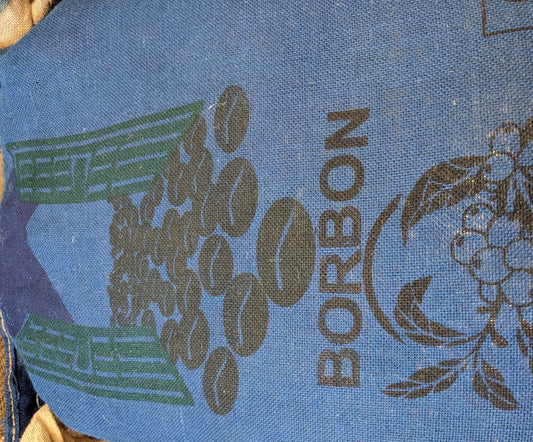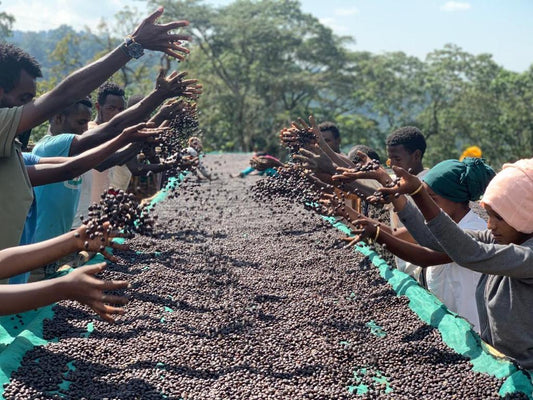Ready to learn more about single origin coffee Vs blends?
Wondering which is best for you?
We've got you covered.
Today, we'll explore the world of blends and single origin coffees and help you understand the differences, the benefits and the disadvantages of each, so you can find your next perfect coffee.
Let's dig in!
What is single origin coffee?
Single origin coffee is coffee where 100% of the beans come from a single origin.
Usually, this means a single farm or producer.
But in some countries, single origin can mean from a single co-op or washing station.
This is most common in many African countries where water and other resources for processing coffee cherries might be more scarce. Many single origin Ethiopian coffees for example are from one washing station or mill.
In either case, the idea of single origin specialty coffee is to ensure maximum traceability and also allow the roaster to hone in on a coffees true origin characteristics.
What is a blend?
A coffee blend is a mix of 2 or more single origin coffees.
Roasters, or sometimes even importers, will combine multiple coffees together to achieve a particular flavour profile or set of cup characteristics.
Blends are produced for many different reasons, but usually it's with the goal of achieving a cup that's consistent, hits a particular flavour profile, or combines multiple positive attributes of different coffees together to produce a cup that's better than the sum of it's parts.
| Advantages | Disadvantages | |
| Single origin |
Origin transparency Highly traceable Often higher quality |
Any floors or shortcomings in the coffee are fully on show Often more expensive (due to higher quality) |
| Coffee blends |
Consistent flavour profile Usually less expensive |
Not origin transparent |
What's better? Single origin or blend?
As with pretty much everything in coffee, that all comes down to personal preference.
What you value and what experience you're seeking with your coffee will play a big role in whether a single origin or a blend is right for you.
If you want consistency. If you want to know you'll be able to find that same flavour profile you like every brew, month in and month out, then a blend might be best for you.
Most blends are developed so that the roaster can easily switch out one or more of the component parts for other similar coffees as needed in accordance with supply and seasonality.
On the other hand, if you want to explore and taste different origins, different processing methods, different varietals and an incredible huge world of flavours, then great quality single origins are where you'll want to be.
As we discussed above, each of these options comes with advantages and disadvantages. Deciding which one is right for you will come down to deciding where you fall in that and how you want to enjoy your coffee.
For us here at Kea Coffee, we're all about origin transparent coffees. So much so that they're all we sell. That doesn't mean they're better or worse than blends. It's just how we like to enjoy our coffee.
Are single origin coffees better quality?
Single origin coffees have to be high quality, because there's nowhere for them to hide.
That doesn't mean that all blends are lower quality. Many speciality roasters have very high quality blends that are probably better quality than many single origins. For example, you could blend together 2 coffees that each have different qualities that compliment each other, and create a blend that gives you the best of both coffees, and therefor a better quality cup than either of the 2 coffees would have had as single origins.
And it doesn't mean that all single origin coffees are automatically high quality either.
But roasters developing a coffee for single origin release have to be mindful of quality first and foremost. There's no covering anything up with a single origin. All of the coffees strengths and weaknesses are going to be right there in the cup.
How can you tell if a coffee is Single Origin or a Blend?
Most specialty coffee roasters will stock a range of single origin coffees and a handful of staple blends.
But how do you know what's what?
Here's a few tips to help you tell the difference.
1. Check the name
Single origin coffees are usually (not always, but often) named after the farm, producer or washing station where they came from.
2. Check for an origin listed on the label or in the product description
Both blends and single origin coffees will often list an origin on the label on the coffee bag or in the product description.
If it has 1 origin listed, it's likely to be a single origin coffee. If it has multiple origins listed, it's a blend.
If information on the packaging in general is scarce, it's more likely to be a blend. Single origin coffees will usually have their origin, as well as other important factors like varietal, growing altitude and roast date clearly on the label.
3. Ask the roaster
As always, if you're unsure about anything, the best thing to do is usually to ask your roaster about their coffees. Most roasters will happily help you learn more about coffee and help you find something you'll enjoy brewing.
Are single origin coffees good for espresso?
Short answer: YES!
We wrote a longer article on how to choose the best coffee beans for espresso, and I recommend reading that if you're on the fence about single origin espresso Vs espresso blends.
In short though, any coffee can work great for espresso, and there are many single origin coffees that pull awesome shots. You can also check out our current range of single origin espressos right here too - these single origin lots are selected because they pull great solo espresso shots but also pair really well with milk too.
Ready to try some great single origin coffees?
Head on over here to check out our current line up.





